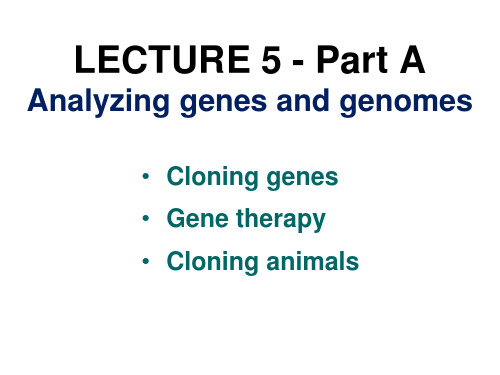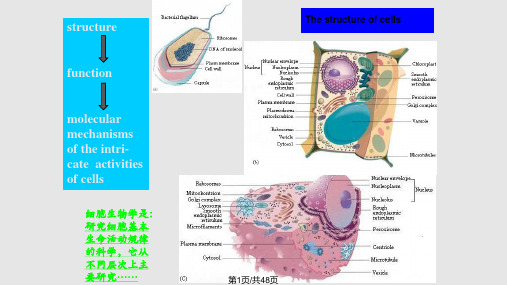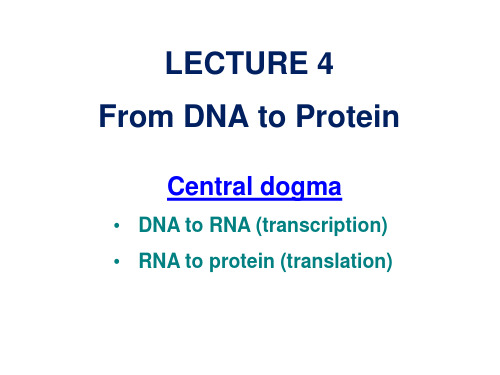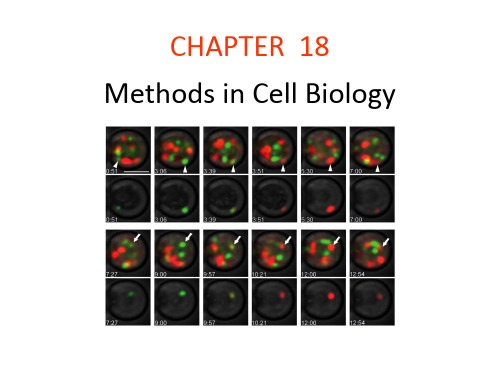细胞生物学英文课件-6.3 转导
合集下载
细胞生物学课件英文版-基因和染色体分析

PCR is used in forensic analysis
VNTRs: Variable Number Tandem Repeats
STRs: short tandem repeats •4 to 40 repeats in various positions (loci)
“DNA fingerprint”
– Conserves energy
• Don’t make what you don’t need!
• Multicellular
– Allows specialization of cell types
– Allows growth and development
• How do we know that
Fig 10-23, 10-24
How can we change DNA information?
Make site specific changes
Transform into a strain that has no
DNA repair
Fig 10-34
Reporter Genes
Fig 10-29
organism • Mechanisms to determine the sequence of DNA • Ways to alter and change DNA sequences • Ways to put DNA back into organisms
• And if we can do all that: use stem cells to alter/repair damage
• What are some of the specialized proteins produced in these cell types?
细胞生物学课件英文版-简介、显微镜

– Recent evidence indicates that prokaryotes are more diverse and numerous than previous thought.
Basic Properties of Cells (6)
• Types of Eukaryotic Cells: Cell Specialization
– Genes encode information to build each cell, ad the organism.
– Genes encode information for cellular reproduction, activity, and structure.
Levels of cellular and molecular organization
Pathways of cell differentiation
composition and metabolic features that have been conserved throughout evolution.
Basic Properties of Cells (2)
Basic Properties of Cells (3)
• Cells Posses a Genetic Program and the Means to Use It
– Cultured cells are an essential tool for cell biologists.
Basic Properties of Cells (2)
• Cells Are Highly Complex and Organized
– Cellular processes are highly regulated. – Cells from different species share similar structure,
Basic Properties of Cells (6)
• Types of Eukaryotic Cells: Cell Specialization
– Genes encode information to build each cell, ad the organism.
– Genes encode information for cellular reproduction, activity, and structure.
Levels of cellular and molecular organization
Pathways of cell differentiation
composition and metabolic features that have been conserved throughout evolution.
Basic Properties of Cells (2)
Basic Properties of Cells (3)
• Cells Posses a Genetic Program and the Means to Use It
– Cultured cells are an essential tool for cell biologists.
Basic Properties of Cells (2)
• Cells Are Highly Complex and Organized
– Cellular processes are highly regulated. – Cells from different species share similar structure,
细胞生物学Introduction of cell biologyPPT课件

Cell organelle (Mitochondria, Chloroplasts, Endomembrane
system, nucleus etc.)
Cytoskeleton System
Cell proliferation and regulation
Cell differentiation and gene expression Cell apoptosis and cellular aging
structure
function
molecular mechanisms of the intricate activities of cells
细胞生物学是: 研究细胞基本 生命活动规律 的科学,它从 不同层次上主 要研究……
The structure of cells
第1页/共48页
The course mainly covers:
第3页/共48页
第4页/共48页
Suggestions to Study Cell Biology
Fundamental Concepts and theories Experimental approaches and ideas (As you read this
text, think like a researcher)
Reductionist (knowledge of the parts of the whole can
explain the character of the whole) Don’t accept everything you read as being true. Remain skeptical! English is just a tool! Take notes when you listened especially what I have emphasized
细胞生物学课件英文版-DNA和染色体

Nucleosomes condense DNA three-fold: what else condenses DNA?
Fig. 5-22
Final levels of chromatin packing: heterochromatin & chromatids
Euchromatin (less condense)
Chromatin organization within a nucleus
Fig. 5-19
Nucleolus: rRNA transcription!
Special parts of chromosomes:
Fig. 5-16
How is the intervening DNA packed & packaged?
strain.
What part of the cell contains genetic material?
Fig. 5-4
What part of the cell contains genetic material?
T2 virus (bacteriophage): contains only DNA and protein Injects the genetic material into the host cell (E. coli)
Fig. 5-7
inside
outside
Fig. 5-6
Genome: complete set of DNA/genetic information
Human cells: ~two meters, ~3.2 x 109 nucleotides, ~25,000 genes
mRNA
Fig. 5-22
Final levels of chromatin packing: heterochromatin & chromatids
Euchromatin (less condense)
Chromatin organization within a nucleus
Fig. 5-19
Nucleolus: rRNA transcription!
Special parts of chromosomes:
Fig. 5-16
How is the intervening DNA packed & packaged?
strain.
What part of the cell contains genetic material?
Fig. 5-4
What part of the cell contains genetic material?
T2 virus (bacteriophage): contains only DNA and protein Injects the genetic material into the host cell (E. coli)
Fig. 5-7
inside
outside
Fig. 5-6
Genome: complete set of DNA/genetic information
Human cells: ~two meters, ~3.2 x 109 nucleotides, ~25,000 genes
mRNA
细胞生物学课件英文版-转录与翻译

Many molecules of RNA polymerase can simultaneously transcribe genes
Types of RNA
Messenger RNA (mRNA): to make proteins Ribosomal RNA (rRNA): ribosomal strural RNA for translation Others: structural RNAs (splicing, telomeres, etc,)
– mRNA is always translated from the 5 end toward the 3 end
Differences
RNA processing
Location
Linking transcription and translation
Fig.7-23
Transcription in Eukaryotes
• Three different RNA polymerases • Must have general transcription factors to initiate
Fig.7-7
Makes more mistakes:~1/104nts
Because RNA is displaced, a second RNA polymerase can immediately follow the first, etc.
Fig.7-8 Differences between RNA and DNA polymerases: ribose vs. deoxyribose, priming, proofreading ability, length of products
Types of RNA
Messenger RNA (mRNA): to make proteins Ribosomal RNA (rRNA): ribosomal strural RNA for translation Others: structural RNAs (splicing, telomeres, etc,)
– mRNA is always translated from the 5 end toward the 3 end
Differences
RNA processing
Location
Linking transcription and translation
Fig.7-23
Transcription in Eukaryotes
• Three different RNA polymerases • Must have general transcription factors to initiate
Fig.7-7
Makes more mistakes:~1/104nts
Because RNA is displaced, a second RNA polymerase can immediately follow the first, etc.
Fig.7-8 Differences between RNA and DNA polymerases: ribose vs. deoxyribose, priming, proofreading ability, length of products
10.Cell differentiation细胞生物学英文课件

2021/2/4
14
Cell differentiation occurs through changes in gene expression
Ultimately, determination and differentiation occur due to differential gene expression, which results from signal transduction.
2021/2/4
Human has about 5 billions cells, More than 400 cell types.
13
Cell differentiation involves in wide range of mechanisms
Molecular biology of differentiation (genetics and epigenetic regulation;
• Hedgehog (HH) pathway, • Bone morphogenetic protein (BMP) pathway, • Transforming growth factor- (TGF-) pathway, • Fibroblast growth factor (FGF) pathway, • Epidermal growth factor (EGF) pathway, • Retinoic acid pathway,视黄酸信号通路 • Wingless (Wnt/Wg) pathway, • Notch pathway, • G-protein-coupled receptors (GPCR) pathway.
2021/2/4
10
Transdifferentiation转分化
细胞生物学课件英文版-细胞膜

An Overview of Membrane Functions
3.1 An Overview of Membrane Functions (1)
• Compartmentalization – Membranes form continuous sheets that enclose intracellular compartments.
– Channel proteins have hydrophilic cores that form aqueous channels in the membranespanning region.
The Structure and Functions of Membrane Proteins (3)
– Glycoproteins have short, branched carbohydrates for interactions with other cells and structures outside the cell.
– Glycolipids have larger carbohydrate chains that may be cell-to-cell recognition sites.
• Membrane proteins can be grouped into three distinct classes
The Structure and Functions of Membrane Proteins (2)
• Integral Membrane Proteins
– Are amphiphatic, with hydrophic domains anchoring them in the bilayer and hydrophilic regions forming functional domains outside of the bilayer.
细胞生物学课件英文版-细胞分裂

cycle.
Fluctuations of cyclin and MPF levels during the cell cycle
The Cell Cycle (6)
• The role of protein kinases (continued)
– MPF-like, cyclin-dependent kinases (Cdks) occur in yeast cells.
The Cell Cycle (12)
• The pairing between individual cyclins and Cdks is specific, and only some combinations are found.
• As in yeast, Cdk1 is the only Cdk required to drive a mammalian cell through the cell cycle.
Combinations between various cyclins and Cdks at different stages in the mammalian cell cycle
The Cell Cycle (13)
• Checkpoints, Kinase Inhibitors, and Cellular Responses
exist mitosis and enter a new cell cycle.
The Cell Cycle (11)
• Subcellular Localization
– Movement of cyclins between the cytoplasm and the nucleus is another point of control.
Fluctuations of cyclin and MPF levels during the cell cycle
The Cell Cycle (6)
• The role of protein kinases (continued)
– MPF-like, cyclin-dependent kinases (Cdks) occur in yeast cells.
The Cell Cycle (12)
• The pairing between individual cyclins and Cdks is specific, and only some combinations are found.
• As in yeast, Cdk1 is the only Cdk required to drive a mammalian cell through the cell cycle.
Combinations between various cyclins and Cdks at different stages in the mammalian cell cycle
The Cell Cycle (13)
• Checkpoints, Kinase Inhibitors, and Cellular Responses
exist mitosis and enter a new cell cycle.
The Cell Cycle (11)
• Subcellular Localization
– Movement of cyclins between the cytoplasm and the nucleus is another point of control.
细胞生物学课件英文版-细胞通讯

More of a long term change
Fig 16-7
Where does the signal transduction pathway start?
The two general classes of signal receptors are:
Fig 16-8
• Signal molecules are large or hydrophilic to diffuse through plasma membrane
LECTURE 8
Cell Communication
• General Principles of Cell Signaling • G-Protein-Coupled Receptors • Enzyme-Couple Receptors
Changing cell behavior depends on cell communication
Receptors can be in the cytosol or nucleus
Fig 16-10
ENDS WITH ALTERED GENE EXPRESSION
Intracellular receptors: Signal receptors can be enzymes
Signal is the dissolved gas: NO
such varied responses in different cells?
Fig 16-7
How can cAMP mediate both of these response pathways?
Fig 16-24
G-protein receptor binds signal, activates a G-protein, signal cascade occurs, alters protein function
12.Immune cells(吴超群)细胞生物学英文课件

Saliva
Washes microbes from surfaces of teeth and mucous membranes of mouth.
Epiglottis 会厌 Prevents microbes and dust from entering trachea.
Urine
Washes microbes from urethra.
2021/2/4
15
Skin and mucous membranes – chemical factors
Gastric juice Destroys bacteria and most toxins in stomach.
Molecules involved; Cytokines, Complement, Acute phase proteins
Adaptive Immunity Antigen dependent A lag period Antigen specific Development of memory T and B Lymphocytes
Inhibit the entrance of many microbes, but not as
membranes effective as intact skin.
Mucus
Traps microbes in respiratory and digestive tracts.
Hairs
Filter microbes and dust in nose.
2021/2/4
11
Thymus
DN - double-negative thymocytes DP - double-positive thymocytes SP - single-positive thymocytes pTECs -progenitor thymic
细胞生物学课件英文版-物质跨膜运输

– Superfamilies of ion channels have been discovered by cloning analysis of protein sequences, site directed mutagenesis, and patch-clamping experiments.
The Na+/K+-ATPase pump
The Movement of Substances Across Cell Membranes (14)
• Other Ion Transport Systems
– The Na+/K+ ATPase (sodium-potassium pump)requires K+ outside, Na+ inside, and is inhibited by ouabain.
– The ratio of Na+:K+ pumped is 3:2.
– The ATPase is a P-type pump, in which phosphorylation causes changes in conformation and ion affinity that allow transport against gradients.
– Insulin stimulates glucose uptake by causing the insertion into the cell membrane of vesicles containing preformed glucose transporters.
The Glucose Transporter
The Movement of Substances Across Cell Membranes (6)
The Na+/K+-ATPase pump
The Movement of Substances Across Cell Membranes (14)
• Other Ion Transport Systems
– The Na+/K+ ATPase (sodium-potassium pump)requires K+ outside, Na+ inside, and is inhibited by ouabain.
– The ratio of Na+:K+ pumped is 3:2.
– The ATPase is a P-type pump, in which phosphorylation causes changes in conformation and ion affinity that allow transport against gradients.
– Insulin stimulates glucose uptake by causing the insertion into the cell membrane of vesicles containing preformed glucose transporters.
The Glucose Transporter
The Movement of Substances Across Cell Membranes (6)
细胞生物学课件英文版-细胞生物学课件英文版-细胞生物学研究方法

The Light Microscope (2)
• Resolution
– Resolution is the ability to see two nearby points as distinct images.
• The numerical aperture is a measure of the lightgathering qualities of a lens.
A comparison of the lens system of a light and electron microscope
Transmission Electron Microscope (3)
• Specimen Preparation for Electron Microscopy
• Visibility
– Visibility deals with factors that allow an object to be observed.
• It requires that the specimen and the background have different refractive indexes.
The Feulgen stain
The Light Microscope (4)
• Preparation of Specimens for Bright-Field Light Microscopy
– A whole mount is an intact object, either living of dead.
– A condenser lens is placed between the electron source and the specimen.
- 1、下载文档前请自行甄别文档内容的完整性,平台不提供额外的编辑、内容补充、找答案等附加服务。
- 2、"仅部分预览"的文档,不可在线预览部分如存在完整性等问题,可反馈申请退款(可完整预览的文档不适用该条件!)。
- 3、如文档侵犯您的权益,请联系客服反馈,我们会尽快为您处理(人工客服工作时间:9:00-18:30)。
The phage infects the cell by “injecting” its genome, which directs the synthesis of new phage.
The phage are released by lysis of the hostges, (烈性噬菌体) including T2
– When these phage with bacterial genes is packaged in their infect cells, the bacterial DNA can have two fates. (1) Most of the time, there is abortive transduction (流产转导). ----The DNA is neither replicated nor integrated into the genome. Why ?
(2) A small proportion of the time (less than 5-10% of the time) the bacterial DNA is integrated into the genome of this host. Complete transduction occurs, involving a double cross-over. Transduction can be used to map closely linked genes.
Generalized transduction – Transfer of random portions of host genomic DNA by bacteriophages during the lytic cycle of virulent or temperate phages.
Any part of the bacterial genome can be transferred.
are made, and the
bacterial chromosome is
broken down into pieces.
Donor bacterial
DNA
Recipient bacterial
DNA
3 Occasionally during phage assembly,
pieces of bacterial DNA are packaged in a phage capsid. Then the donor cell lyses and releases phage particles containing bacterial DNA.
Recipient cell
4 A phage carrying bacterial
DNA infects a new host cell, the recipient cell.
Recombinant cell
5 Recombinant can occur,
producing a recombinant cell with a genotype different from both the donor and recipient cells.
Transduction
Sometimes, segments of the host genome are transferred by phage. This process is generalized transduction transduction(普 遍性转导)
Does the transduction form a partial diploid ?
Transduction
• Transduction is the transfer of bacterial genes in phage particles.
– When phages lyse cells, the bacterial genome is usually degraded. Sometimes, fragments of the bacterial genome similar in size to the phage genome will be packaged into phage particles.
Phage Represent the Third Mechanism
Bacteria can also exchange genes by the process of transduction( 转导), which involves the exchange of genes through phage(噬菌体).
Generalized transduction
Recombinant
Phage protein coat
Bacterial chromosome
Bacterial DNA
Phage DNA
1 A phage infects the
donor bacterial
cell.
2 Phage DNA and proteins
The phage genome directs the synthesis of new phage. These phage are released, lysing (裂 解)the host.
The Lytic Cycle (溶菌周期)
The lytic cycle is a general phage life cycle.
Phage (also called
bacteriophage)
are
viruses that infect bacteria.
Bacteriophage
This shows the DNA phage T4.
A small set of genes are encoded by DNA that is “injected” into the host.
The phage are released by lysis of the hostges, (烈性噬菌体) including T2
– When these phage with bacterial genes is packaged in their infect cells, the bacterial DNA can have two fates. (1) Most of the time, there is abortive transduction (流产转导). ----The DNA is neither replicated nor integrated into the genome. Why ?
(2) A small proportion of the time (less than 5-10% of the time) the bacterial DNA is integrated into the genome of this host. Complete transduction occurs, involving a double cross-over. Transduction can be used to map closely linked genes.
Generalized transduction – Transfer of random portions of host genomic DNA by bacteriophages during the lytic cycle of virulent or temperate phages.
Any part of the bacterial genome can be transferred.
are made, and the
bacterial chromosome is
broken down into pieces.
Donor bacterial
DNA
Recipient bacterial
DNA
3 Occasionally during phage assembly,
pieces of bacterial DNA are packaged in a phage capsid. Then the donor cell lyses and releases phage particles containing bacterial DNA.
Recipient cell
4 A phage carrying bacterial
DNA infects a new host cell, the recipient cell.
Recombinant cell
5 Recombinant can occur,
producing a recombinant cell with a genotype different from both the donor and recipient cells.
Transduction
Sometimes, segments of the host genome are transferred by phage. This process is generalized transduction transduction(普 遍性转导)
Does the transduction form a partial diploid ?
Transduction
• Transduction is the transfer of bacterial genes in phage particles.
– When phages lyse cells, the bacterial genome is usually degraded. Sometimes, fragments of the bacterial genome similar in size to the phage genome will be packaged into phage particles.
Phage Represent the Third Mechanism
Bacteria can also exchange genes by the process of transduction( 转导), which involves the exchange of genes through phage(噬菌体).
Generalized transduction
Recombinant
Phage protein coat
Bacterial chromosome
Bacterial DNA
Phage DNA
1 A phage infects the
donor bacterial
cell.
2 Phage DNA and proteins
The phage genome directs the synthesis of new phage. These phage are released, lysing (裂 解)the host.
The Lytic Cycle (溶菌周期)
The lytic cycle is a general phage life cycle.
Phage (also called
bacteriophage)
are
viruses that infect bacteria.
Bacteriophage
This shows the DNA phage T4.
A small set of genes are encoded by DNA that is “injected” into the host.
